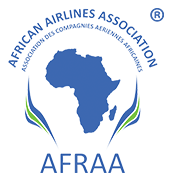AFRAA Secretary General – Mr Abderahmane Berthé, delivered a keynote address at the 53rd Annual General Assembly of the Airlines Association of Southern Africa (AASA).
He made a brief on the state of the airline industry highlighting traffic, connectivity and profitability performance of African airlines and articulated on AFRAA actions on blocked funds, affordability, environmental sustainability and Sustainable Aviation Fuels.
On traffic performance, as at September 2023, the traffic exceeded the level of the same month in 2019 by reaching 101.4%. The traffic repartition for the first semester of 2023 was as follows:
- North Africa represented 40.1% of the total traffic, of which 17% is domestic, and 57% is directed to Europe.
- Central and West Africa represented 20.8% of the total traffic, of which 49% is domestic, and 43% of the non-domestic traffic is intra-Africa.
- Eastern Africa represented 18.7% of the total traffic, of which 45% is domestic, and 30% of the international traffic is directed to Europe.
- The Southern African region represented 20.4% of the total traffic, of which 64% is domestic. 50% of the non-domestic traffic is intra-African, mainly within the sub-region. 19% of the traffic is Intercontinental, of which 28% is directed to Europe.
In terms of connectivity, the total number of intercontinental routes operated by African airlines exceeded the pre-COVID levels since October 2022. In some major airports (Nairobi, Addis Ababa, Lusaka, Cairo, Abidjan, and Lomé), the intra-Africa connectivity has reached or exceeded the pre-Covid level since December 2022.
With regards to revenue losses attributed to Covid-19 impacts, Mr Berthé reported that the 2022 full-year cumulative airline revenue gap was US$3.5 billion for all African airlines compared to 2019. Though the full-year estimated revenue gap is yet to be computed, 2023 will be better.
In terms of cargo performance, he reported that the average market share of African Airlines per cargo origin was 30.6% Year-to-date for August 2023. East Africa comes first with 37%, followed by North Africa with 30%. The highest cargo traffic growth year on year is in North Africa, with 20% Year to date. For the southern African region, Mr Berthé reported that Cape Town and Harare were the top two airports in the region in terms of cargo traffic growth, year to date.
The issue of blocked funds in many countries is challenging for African airlines. The total blocked funds reported in September 2023 by eleven (11) AFRAA member airlines is approximately US$391.8. Mr Berthé informed the Assembly that AFRAA has established a Blocked Funds Task Force with some member airlines to engage with the concerned states to unlock the funds. “We call upon governments to consider Aviation as a priority sector and reduce blocked funds,” he stated.
In terms of connectivity, the level has exceeded the pre-Covid level. However, it still remains low in regard to the potential. 85% of flights are direct, and 15% are connecting flights. Only 21% of the direct flights are operated under the 5th freedom traffic rights. “This is a concern because, for many airlines, the 5th freedom traffic can improve the routes’ profitability and intra-Africa connectivity.” Mr Berthé stated.
The global average GDP per capita in 2023 is $13,920. Twenty-five (25) African countries have a per capita income of less than $1,000, while only eight (8) have more than $5,000 per capita.
“A strong and consistent middle-class citizenry in the African continent is needed to boost intra-Africa traffic.” Mr Berthé stated. For a given average trip length, taxes excluded, ticket fares are more expensive in Africa. On average, ticket fares are twice and thrice higher than in Europe and Asia.
“With high fares and lower GDP per capita, air transport is not affordable for African citizens.” he added.
With regards to environmental sustainability, Mr Berthe reported that in 2021, aviation accounted for over 2% of global CO2 emissions. Aviation-related emissions have grown faster than road, rail, or shipping in recent decades.
Carbon emissions from commercial flights are set to triple by 2050 amid surging travel and freight demand. Nonetheless, emissions could be slashed through aircraft technology, operations efficiency, and alternative fuels.
“AFRAA members are committed to the global industry efforts towards the reduction of CO2 emissions and mitigating the impact of aviation on climate.” Mr Berthé added.
As the global Aviation industry focuses on Sustainable Aviation Fuel (SAF), Africa has an opportunity to act as a leader in feedstock production. However, there are concerns about the SAF production in volume, accessibility at airports, and cost, which is currently high. AFRAA is engaged to work with stakeholders on actions towards the 2050 Net Zero emissions goal.
Highlighting that the enhancement and promotion of safety are among AFRAA’s priorities, Mr Berthé stated that: “While we have the challenge of aviation professionals, our focus should also be on safety to sustain our business.”
He announced that AFRAA and Flight Safety Foundation (FSF) will launch the 1st Africa Safety and Operations Summit on 15 May 2024, back-to-back with the Aviation Stakeholders Convention (ASC) in Addis Ababa hosted by Ethiopian Airlines.
“At AFRAA, we stand willing and ready to collaborate to transform African Aviation into a vibrant logistic service sustaining the economic development in Africa.” He concluded.
The event was hosted by TAAG Angolan Airlines under the theme “Possibilities from Realities.”
